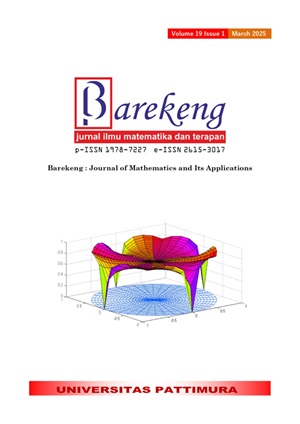ENSEMBLE BAGGING WITH ORDINAL LOGISTIC REGRESSION TO CLASSIFY TODDLER NUTRITIONAL STATUS
Abstract
One problem in classifying stunting data is that the data used does not have a balanced proportion. This study aims to apply the logistic regression classification method with ordinal scale response variables to overcome class imbalance through the ensemble bagging approach. The data used is secondary data in the form of final research reports that have been tested for validity and reliability. The predictor variables used are economic conditions, health services and the environment with categorical response variables, namely the nutritional status of toddlers in the categories of stunting, normal and high. The methods used are ordinal logistic regression and ensemble bagging on ordinal logistic regression with bootstraps of 100, 500, and 1000. The variables that influence the nutritional status of toddlers are Economic Conditions, Health Services, and the Environment. The results of the study showed that the accuracy, sensitivity, specificity, and F1-Score for ordinal logistic regression were smaller than ensemble bagging in ordinal logistic regression. The best classification method obtained was bagging logistic regression with a bootstrap number of 500 and obtained an accuracy value of 85%, sensitivity of 87.2%, specificity of 72.6%, and F1-Score of 79.3%.
Downloads
References
J. Jajang, N. Nurhayati, and S. J. Mufida, “ORDINAL LOGISTIC REGRESSION MODEL AND CLASSIFICATION TREE ON ORDINAL RESPONSE DATA,” BAREKENG: Jurnal Ilmu Matematika dan Terapan, vol. 16, no. 1, pp. 075–082, Mar. 2022, doi: 10.30598/barekengvol16iss1pp075-082.
R. D. Fitriani, H. Yasin, and Tarno, “PENANGANAN KLASIFIKASI KELAS DATA TIDAK SEIMBANG DENGAN RANDOM OVERSAMPLING PADA NAIVE BAYES (Studi Kasus: Status Peserta KB IUD di Kabupaten Kendal),” Jurnal Gaussian, vol. 10, no. 1, pp. 11–20, 2021.
G. Ngo, R. Beard, and R. Chandra, “Evolutionary bagging for ensemble learning,” Neurocomputing, vol. 510, pp. 1–14, Oct. 2022, doi: 10.1016/j.neucom.2022.08.055.
F. Aziz, “Peningkatan performance Logistic Regression menggunakan teknik Ensemble Bagging pada kasus Credit Scoring,” Journal of System and Computer Engineering (JSCE), vol. 1, no. 1, pp. 21–27, Jul. 2020, doi: 10.47650/jsce. v1i1.75.
E. Rahmawati and C. Agustina, “Implementasi Teknik Bagging untuk Peningkatan Kinerja J48 dan Logistic Regression dalam Prediksi Minat Pembelian Online,” Jurnal Teknologi Informasi dan Terapan, vol. 7, no. 1, pp. 16–19, Jun. 2020, doi: 10.25047/jtit. v7i1.123.
L. M. Cendani and A. Wibowo, “Perbandingan Metode Ensemble Learning pada Klasifikasi Penyakit Diabetes,” JURNAL MASYARAKAT INFORMATIKA, vol. 13, no. 1, pp. 33–44, May 2022, doi: 10.14710/jmasif.13.1.42912.
A. B. Astuti, A. Efendi, S. Astutik, and E. Sumarminingsih, Analisis Data Kategorik Menggunakan R: Teori dan Aplikasinya pada Berbagai Bidang. Malang: UB Press, 2020.
A. Efendi, R. Fitriani, H. I. Naufal, and B. Rahayudi, “ENSEMBLE ADABOOST IN CLASSIFICATION AND REGRESSION TREES TO OVERCOME CLASS IMBALANCE IN CREDIT STATUS OF BANK CUSTOMERS,” J Theor Appl Inf Technol, vol. 98, no. 17, pp. 3428–3437, 2020.
J. Friedman, T. Hastie, and R. Tibshirani, “Additive logistic regression: a statistical view of boosting (With discussion and a rejoinder by the authors),” The Annals of Statistics, vol. 28, no. 2, Apr. 2000, doi: 10.1214/aos/1016218223.
A. A. R. Fernandes and Solimun, “Menelisik Faktor-Faktor Penyebab Stunting pada Anak di Kecamatan Wajak: Integrasi Cluster dengan Path Analysis dengan Pendekatan Statistika dan Sains Data,” 2023.
D. Wahyuni and R. Fitrayuna, “PENGARUH SOSIAL EKONOMI DENGAN KEJADIAN STUNTING PADA BALITA DI DESA KUALU TAMBANG KAMPAR,” PREPOTIF Jurnal Kesehatan Masyarakat, vol. 4, no. 1, pp. 20–26, 2020.
R. A. Utami, A. Setiawan, and P. Fitriyani, “Identifying causal risk factors for stunting in children under five years of age in South Jakarta, Indonesia,” Enferm Clin, vol. 29, pp. 606–611, Sep. 2019, doi: 10.1016/j.enfcli.2019.04.093.
N. B. Brahmana, V. S. Manalu, D. Nababan, T. R. Sinaga, and F. L. Tarigan, “Faktor-Faktor yang Berhubungan dengan Kejadian Stunting Pada Balita di Desa Marbun Tonga Marbun Dolok Kecamatan Hasundutan Tahun 2021,” Journal of Healthcare Technology and Medicine, vol. 7, no. 2, pp. 2615–109, 2021.
L. Cameron, C. Chase, S. Haque, G. Joseph, R. Pinto, and Q. Wang, “Childhood stunting and cognitive effects of water and sanitation in Indonesia,” Econ Hum Biol, vol. 40, p. 100944, Jan. 2021, doi: 10.1016/j.ehb.2020.100944.
M. R. Putri, T. Y. Handayani, and D. P. Sari, “Pengaruh Sanitasi Lingkungan Terhadap Kejadian Stunting Pada Balita,” JURNAL KESEHATAN MERCUSUAR, vol. 5, no. 1, pp. 63–68, Apr. 2022, doi: 10.36984/jkm.v5i1.260.
T. Mahmudiono, S. Sumarmi, and R. R. Rosenkranz, “Household dietary diversity and child stunting in East Java, Indonesia,” Asia Pac J Clin Nutr, vol. 26, no. 2, pp. 317–325, Jan. 2017, [Online]. Available: https://search.informit.org/doi/10.3316/ielapa.688058173877148
T. Beal, A. Tumilowicz, A. Sutrisna, D. Izwardy, and L. M. Neufeld, “A review of child stunting determinants in Indonesia,” Matern Child Nutr, vol. 14, no. 4, Oct. 2018, doi: 10.1111/mcn.12617.
Copyright (c) 2025 Luthfia Hanun Yuli Arini, Solimun Solimun, Achmad Efendi, Adji Achmad Rinaldo Fernandes

This work is licensed under a Creative Commons Attribution-ShareAlike 4.0 International License.
Authors who publish with this Journal agree to the following terms:
- Author retain copyright and grant the journal right of first publication with the work simultaneously licensed under a creative commons attribution license that allow others to share the work within an acknowledgement of the work’s authorship and initial publication of this journal.
- Authors are able to enter into separate, additional contractual arrangement for the non-exclusive distribution of the journal’s published version of the work (e.g. acknowledgement of its initial publication in this journal).
- Authors are permitted and encouraged to post their work online (e.g. in institutional repositories or on their websites) prior to and during the submission process, as it can lead to productive exchanges, as well as earlier and greater citation of published works.






1.gif)



